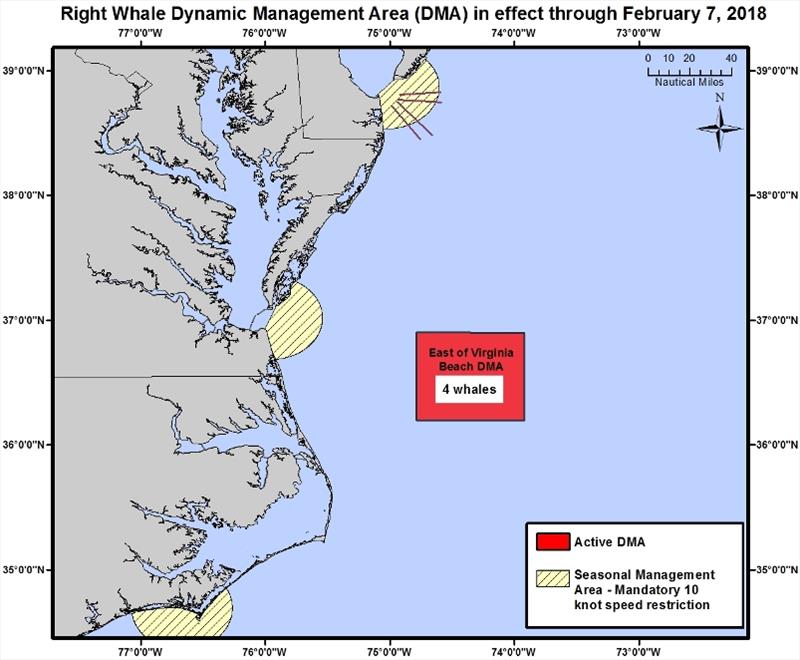
NOAA works to address right whale mortalities
by NOAA Fisheries 2 Feb 2018 23:45 UTC

New dynamic management area © NOAA Fisheries
We are investigating a report of a dead North Atlantic right whale off the coast of Virginia/North Carolina on Monday, January 22.
The Virginia Aquarium Stranding Response Program received notification of the whale, along with a photo of the carcass, on the evening of Wednesday, January 24. The whale has been positively identified as a North Atlantic right whale (Eubalaena glacialis), and appears to be wrapped in line in a manner that, based on past observations of entanglements, suggests the whale was alive and swimming when it encountered the line.
NOAA Fisheries requested a drift analysis from the Coast Guard to determine where the carcass might be, and to determine whether the whale can be towed to shore and necropsied. At this point, we are not able to confirm the whale’s sex or match its identity with the photo-id catalog of known individuals that scientists maintain for the population.
This is the first reported mortality of a North Atlantic right whale in 2018.
New dynamic management area
Shortly after receiving the report of the dead right whale, we were alerted to the presence of four live right whales in the same general area, prompting the establishment of a voluntary vessel speed restriction zone (Dynamic Management Area or DMA). The DMA has been established 86 nm east-southeast of Virginia Beach, VA to protect the aggregation of right whales sighted in this area by a U.S. military ship on January 23, 2018.
This DMA is in effect immediately through February 7.
Mariners are requested to route around this area or transit through it at 10 knots or less.
East-Southeast of Virginia Beach, Virginia DMA -- in effect through February 7, 2018
36 54 N
36 12 N
074 47W
073 55 W
2017 was a devastating year for right whales
The year 2017 was devastating for North Atlantic right whales, which suffered a loss of 17 whales--about 4 percent of their population--an alarming number for such a critically endangered species with a population currently estimated at about 450 animals.
Of the 17 dead whales, 12 were found in Canadian waters and 5 were found in U.S. waters. The whales in Canada were discovered in the Gulf of St. Lawrence between June and September. Canadian officials performed necropsies on seven of these whales, and found that five died to blunt force trauma (often associated with vessel strikes) and two died due to entanglements from fishing gear.
Of the five dead right whales found in U.S. waters in 2017, all were found in waters off the coast of Massachusetts. One (a young calf) was confirmed to have died of blunt force trauma. We were unable to determine a cause of death for the other four (all adults) because they were in advanced states of decomposition.
There are currently only about 100 females of breeding age in the population and more females seem to be dying than males. Births have also been declining in recent years, and to date, no new calves have been spotted in the calving grounds off Florida this year.
In August 2017, NOAA Fisheries declared the increase in right whale mortalities an “Unusual Mortality Event,” which helps the agency direct additional scientific and financial resources to investigating, understanding, and reducing the mortalities in partnership with the Marine Mammal Stranding Network, Canada’s Department of Fisheries and Oceans, and outside experts from the scientific research community.
Taking action to protect right whales
While the North Atlantic right whale population has increased since we began our recovery efforts more than two decades ago, this most recent decline and the large number of recent mortalities are a serious concern, and reminds us that we still have a long way to go to recover this species. Read more about our Atlantic Large Whale Take Reduction Plan, our Large Whale Disentanglement Program, and our Ship Strike Reduction program, which has helped reduce serious injuries and mortalities caused by vessel strikes. Find out about the actions we are currently taking to help right whales.
Next month, the first meetings of two Atlantic Large Whale Take Reduction Team subgroups investigating the feasibility of ropeless gear and whale-release rope and gear marking will be convened. John Bullard’s (former Regional Administrator for the Greater Atlantic Region) guest column, which begins on page three of the Maine Lobstermen’s Association January Newsletter, provides context on the challenges and urgency surrounding this and our other efforts.
On Tuesday, Canada’s Department of Fisheries and Oceans Minister Dominic LeBlanc announced four measures for the snow crab fishery in the southern Gulf of St. Lawrence to protect North Atlantic right whales from entanglement. These measures complement several measures in place in the U.S., including gear marking for trap/pot gear and reducing the amount of floating rope on the water’s surface.
Report a stranded marine mammal
If you see or have any information about a stranded marine mammal, please report it to our stranding hotline 866-755-NOAA (6622) or to your local stranding response organization.